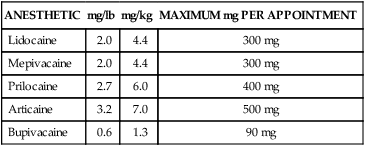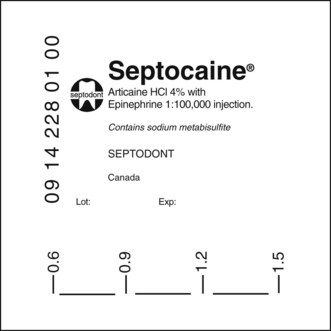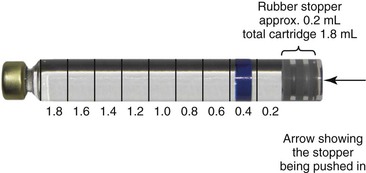Determining Drug Doses
1. Calculate maximum recommended doses (MRDs) for local anesthetic.
2. Calculate MRDs for vasoconstrictors for a healthy patient and a medically compromised patient.
3. Successfully complete review questions and activities for this chapter.
Introduction
To increase the safety of the patient during the administration of local anesthetics and vasoconstrictors, the dental hygienist must always administer the smallest clinically effective dose. This is especially critical when administering anesthetics and vasoconstrictors to the medically compromised patient. Each cartridge of solution may contain either one drug (the anesthetic) or two drugs (the anesthetic and vasoconstrictor, including a preservative). The maximum recommended dose (MRD) of the solution that contains both the anesthetic and vasoconstrictor is dependent upon which of the two drugs reaches its MRD first. The drug that limits the total amount of volume delivered is referred to as the limiting drug. (See Box 8-1.)
All drugs have maximum dose levels, including local anesthetics and vasoconstrictors, which are determined by the manufacturer based on results from animal and human studies. These doses can be found in the product inserts. The maximum doses determined by the manufacturer have been reviewed by the Council on Dental Therapeutics of the American Dental Association and the United States Pharmacopeial (USP) Convention.1,2 Dosage guidelines for local anesthetics and vasoconstrictors are also offered by recognized experts in the field, such as Malamed3, and are usually more conservative doses than those recommended by the ADA council, the USP, or the manufacturer.3 The dental hygienist must decide which maximum dose is the appropriate level based on the treatment to be delivered, and the health status of the patient. The information presented in this chapter assists the dental hygienist in determining the appropriate dosage to be administered.
Maximum Recommended Doses of Local Anesthetics
The MRD for a local anesthetic is defined as the highest amount of an anesthetic drug that can be safely administered without complication to a patient while maintaining its efficacy. MRDs should also be adjusted to consider the patient’s overall health and any mitigating medical factors that could hamper the patient’s recovery. These amounts are determined based on maximum dosage for each appointment. The dosage calculation is based on the patient’s weight, and can be calculated based on milligrams per pound (mg/lb) or milligrams per kilogram (mg/kg). As discussed previously, each practitioner should determine which recommendation to follow. This author recommends, and will follow, the more conservative guidelines3. Table 8-1 provides the MRD per appointment for each local anesthetic recommended in this text.
TABLE 8-1
Maximum Recommended Doses of Local Anesthetic Agents per Appointment for Healthy Patients*
| ANESTHETIC | mg/lb | mg/kg | MAXIMUM mg PER APPOINTMENT |
| Lidocaine | 2.0 | 4.4 | 300 mg |
| Mepivacaine | 2.0 | 4.4 | 300 mg |
| Prilocaine | 2.7 | 6.0 | 400 mg |
| Articaine | 3.2 | 7.0 | 500 mg |
| Bupivacaine | 0.6 | 1.3 | 90 mg |

*MRD listed for the local anesthetic drug is determined for anesthetic drug only, not the vasoconstrictor; dosages must be reduced for children, older adults, and medically compromised patients.
Calculation of Maximum Recommended Dose for Local Anesthetics
All MRDs per appointment are calculated first based on milligrams (See Box 8-2 for dosing facts). Information needed to complete the MRD calculation is:
2. The drug concentration expressed as a percentage, 0.5%, 2%, 3%, or 4%
3. Amount of local anesthetic in a standard cartridge
4. The maximum recommended dose for the selected anesthetic based upon milligrams per pound or mg per kilogram. (See Table 8-1.)
For clinical practicality, this amount can then be converted to maximum number of cartridges per appointment and maximum number of milliliters per appointment. The following are steps for calculating MRDs (Box 8-3).
Step 1: Obtain necessary patient information
The dental hygienist must first obtain the necessary patient information before beginning the drug calculation. The selection of the anesthetic drug that will be administered will be determined by the treatment to be rendered and the patient’s medical history (see Chapter 7). Once the drug is determined, the dental hygienist must obtain the patient’s weight to determine the local anesthetic calculation.
Step 2: Calculate milligrams (mg) of selected anesthetic in one cartridge
The number of milligrams of anesthetic solution in one cartridge is determined by the percentage of local anesthetic per milliliter of solution. Most standard local anesthetic cartridges are designed to contain 1.8 mL of solution, some manufacturers label their cartridges as containing a minimum of 1.7 mL of solution (See Box 8-4.)
This small variance will not alter the calculation formula. Therefore, 1.8 mL will be used in all dosing formulas even for cartridges labeled as containing 1.7 mL. Some regional local anesthesia board examinations are currently requiring the candidate to calculate drug doses based on both 1.7 mL and 1.8 mL. A special appendix has been included at the end of this chapter to assist licensure candidates who will be taking these examinations. (See Appendix 8-2 and Box 8-4.)
< ?xml:namespace prefix = "mml" />

Table 8-2 lists the local anesthetic concentrations in percentage of solution, mg/mL, and total number of milligrams per cartridge.
TABLE 8-2
Calculation of mg per Cartridge for Varying Anesthetic Concentrations
| LOCAL ANESTHETIC CONCENTRATION (%) | NUMBER OF mg/mL | MULTIPLY BY mg IN ONE CARTRIDGE OF ANESTHETIC | NUMBER OF mg/CARTRIDGE |
| 2% | 20 | 1.8 | 36 |
| 3% | 30 | 1.8 | 54 |
| 4% | 40 | 1.8 | 72 |
| 0.5% | 5 | 1.8 | 9 |

Step 3: Calculate patient’s MRD of anesthetic in mg
The patient’s MRD is the dose in mg that can be delivered to a patient in one appointment. For most dental hygiene procedures requiring anesthesia, this dose will most likely never be reached. The dosage calculation for the MRD is based on the patient’s weight, and can be calculated based on maximum milligrams per pound (mg/lb) or maximum milligrams per kilogram (mg/kg) (see Table 8-1). To calculate the number of milligrams the patient can receive of the chosen anesthetic, multiply the patient’s weight (lbs or kgs) by the MRD (mg/lb or mg/kg) listed in Table 8-1. (See Box 8-5 for dosage calculation example.) The absolute MRD is the absolute maximum dose that any patient can receive per appointment, regardless of their weight. For example, a 200-lb patient can receive only 300 mg of lidocaine 2% even though the calculated number based upon his weight is higher. These MRDs are typically based on healthy adult patients weighing 150 pounds, with only a few exceptions. For lidocaine and mepivacaine the MRD per appointment is 300 mg, and any patient weighing more than 150 pounds should receive no more than 300 mg. of either of these drugs. (Table 8-1 lists MRDs for each local anesthetic drug.)
Step 4: Convert MRD of anesthetic to cartridges
Because local anesthetic solutions are administered in single-use cartridges, the dental hygienist must convert the MRD in milligrams (described in step 3) to the maximum number of cartridges to make this clinically practical. This is accomplished by dividing the MRD in milligrams (step 3) by the number of milligrams per cartridge of anesthetic (step 2). (See Box 8-6 for dosage calculation example).
Step 5 (Optional): Convert maximum cartridges of anesthetic to milliliters
In one cartridge of solution there is 1.8 mL. To convert the maximum number of cartridges to maximum number of milliliters, multiply the number of cartridges by 1.8. (See Box 8-7 for dosage calculation example.) This step is optional and only necessary if the clinician would like to know the maximum number of mL.
Calculating Milligrams of anesthetic Administered

• Some manufacturers place volume indicators on the anesthetic cartridges, allowing the clinician to deposit precise volumes of anesthetic or to determine precisely how much anesthetic was delivered (Figure 8-1).
• If the cartridge does not have a volume indicator label, the clinician can determine the local anesthetic volume by the width of the rubber stopper. Each rubber stopper deposits approximately 0.2 mL of solution from a 1.8 mL cartridge (Figure 8-2).
• If the dental hygienist deposited one cartridge and three stoppers of the second cartridge of mepivacaine 3%, the calculation of administered drug would be as follows:

Calculating Additional Doses of the Same Drug

or

As discussed earlier, if the dental hygienist administered two cartridges of 3% mepivacaine, the patient received 108 mg of the MRD of 240 mg. To determine how many more milligrams of drug (mepivacaine) this patient can receive, subtract the MRD (240 mg) by the dose administered (108 mg).

The patient can receive 132 more mg of mepivacaine 3%.

The patient can receive 2.4 additional cartridges of 3% mepivacaine.
Calculating Additional Doses of Different Drugs
In some instances, the dental hygienist may need to administer a different anesthetic drug to a patient after a drug has already been administered. Although this is uncommon, the situation may arise, and the dental hygienist must know how to calculate the amount of the new drug he or she can safely administer. There is no guaranteed formula to calculate this number.3 However, a commonly used method to ensure that the total dose of the two drugs does not exceed the MRD of the most toxic drug, the lower of the two individual MRDs should be used to calculate the amount of the second drug.3 The following steps describe this method for a 130-lb healthy patient using 2% lidocaine as drug number one (two cartridges already administered) and switching to 4% prilocaine as drug number two as an example: (See Box 8-8 for summary of steps.)
Stay updated, free dental videos. Join our Telegram channel

VIDEdental - Online dental courses






